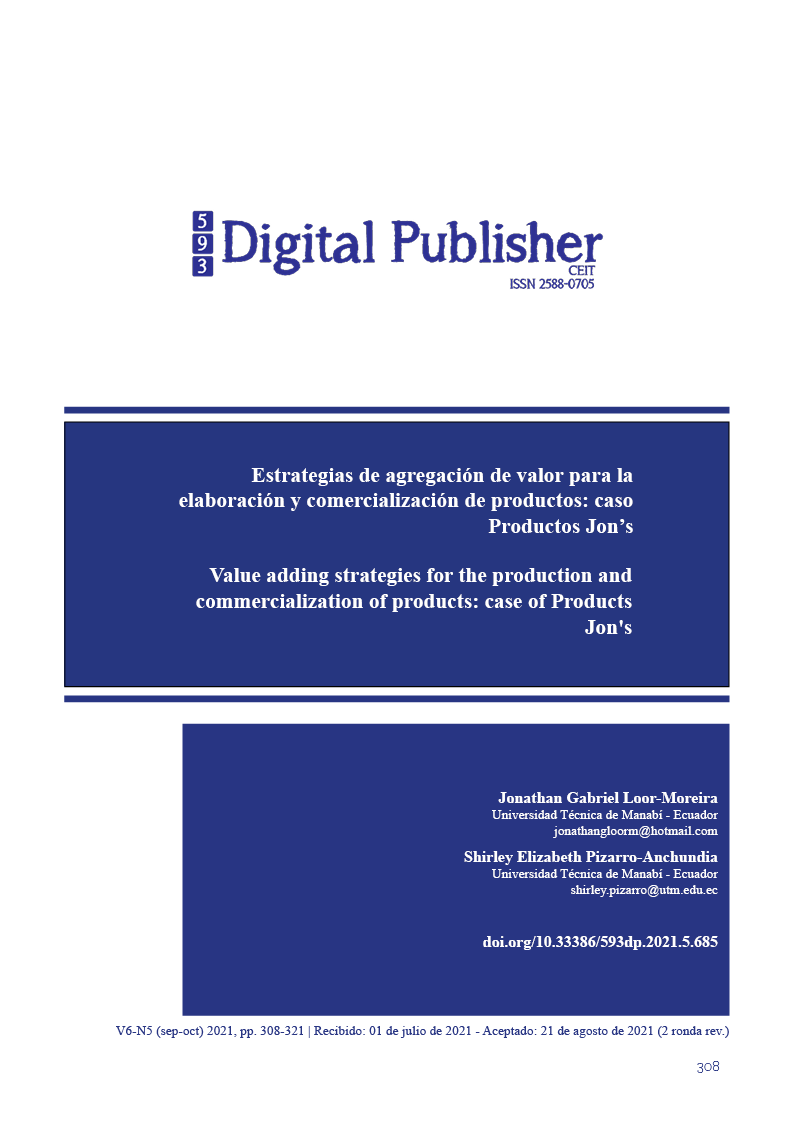Estrategias de agregación de valor para la elaboración y comercialización de productos: caso Productos Jon’s
Main Article Content
Abstract
The value chain is known as the range of activities that is required to carry a product or service from its conception, passed through the intermediate phases of production and delivery to consumers and its final disposal after its use, the line of The finished products of the company Productos Jon's are called: Jon's Schnapps Cocktails, Jon's Shot Cocktails and El Ceibo Whiskey, for the elaboration processes are used to which added value will be implemented, the objective of the investigation was to analyze the incidence of value-adding strategies in the production and commercialization, for this an explanatory-level investigation was carried out, with empirical design using methods such as the observation made to the production process, the interview with the company administrator and the market study, to determine the sample The statistical formula for finite populations was used, resulting in 384 potential customers, who were selected randomly in order to apply the instrument developed and thus identify the market segment, it was concluded that the value-adding strategies for production and marketing correspond to differentiation, innovation and marketing, these have a significant impact on positive in the production phases through quality control and supervision at the beginning of the production process phase and in the marketing phase of the products using the channels according to the results of the market study.
Downloads
Article Details

This work is licensed under a Creative Commons Attribution-NonCommercial-ShareAlike 4.0 International License.
1. Derechos de autor
Las obras que se publican en 593 Digital Publisher CEIT están sujetas a los siguientes términos:
1.1. 593 Digital Publisher CEIT, conserva los derechos patrimoniales (copyright) de las obras publicadas, favorece y permite la reutilización de las mismas bajo la licencia Licencia Creative Commons 4.0 de Reconocimiento-NoComercial-CompartirIgual 4.0, por lo cual se pueden copiar, usar, difundir, transmitir y exponer públicamente, siempre que:
1.1.a. Se cite la autoría y fuente original de su publicación (revista, editorial, URL).
1.1.b. No se usen para fines comerciales u onerosos.
1.1.c. Se mencione la existencia y especificaciones de esta licencia de uso.
References
Alfaro Giménez, J., & Pina Massachs, M. (2018). LA - Empresa y Administracion GM. Libro alumno. Mc Graw Hill, 31–45. https://www.mheducation.es/bcv/guide/ capitulo/8448614224.pdf
ARCSA. (2020). ARCSA asiste a fabricantes de licor artesanal de cantón Junín. https://www.controlsanitario.gob.ec/
Arechavaleta Vázquez, E. F. (2015). Estrategias de comercialización. Tendencias de Innovación En La Ingeniería de Alimentos, 169–195. https://doi.org/10.3926/oms.292
Bonmatí, J. (2011). El valor de una empresa y la creación de valor en esa empresa. Revista Contable, XXXIX, 10–12. https://www.aece.es/servicios- contenido_68.html
Carrión, J., & Consolación, C. (2006). La diferenciación como estrategia. MK Marketing + Ventas, 52–56. http://pdfs.wke.es/9/6/0/4/pd00000196 04.pdf
Carro Paz, R., & González Gómez, D. (2014). Administración de las operaciones. http://nulan.mdp.edu.ar/1608/1/03_estr ategia_operaciones.pdf
Chirinos, R., & Rosado, J. (2016). Estrategia de diferenciación: el caso de las empresas industriales. Ingeniería Industrial, 34,1025–9929. https://www.redalyc.org/pdf/3374/3374 50992008.pdf
Dalle, L. (2006). Grow or go: A theory-build- ing study regarding the survival and growth of micro-small enterprises. Southern Cross University, New South Wales, Australia.
Espinosa, R. (2013). Marketing mix Producto
-Precio -Plaza -Promoción. In Universidad De La Republica. http://www.fadu.edu.uy/marketing/files/ 2013/04/marketing_mix_producto.pdf
Gallegos, M., Beltrán, L., Calderón, L., & Guerra, V. (2020). La diferenciación como estrategia de competitividad en el sector florícola del Cantón Cayambe (Ecuador). Espacios, 41(10). https://www.revistaespacios.com/a20v 41n10/a20v41n10p02.pdf
Infante, F. (2016). La importancia de los factores productivos y su impacto en las organizaciones agrícolas en León Guanajuato México. Agora U.S.B., 16(2), 393.
https://doi.org/10.21500/16578031.244 3
Jordán Sanchéz, J. (2011). La innovación: una revisión teórica desde la perspectiva de marketing. Perspectivas, 27, 47–71. https://www.redalyc.org/pdf/4259/4259 41231004.pdf
Nutz, N. ., & Sievers, M. (2016). Guía General para el Desarrollo de Cadenas de Valor.
https://www.ilo.org/wcmsp5/groups/pub lic/---ed_emp/---emp_ent/---
ifp_seed/documents/instructionalmateri al/wcms_541432.pdf
Organización Mundial de la Propiedad Intelectual, (OMPI). (2012). Clasificación Internacional De Productos Y Servicios: Para El Registro De Marcas.
Palma, H. G. H., Sierra, D. M., & Arbelaez,
D. C. (2010). Enfoque basado en procesos. SABER, CIENCIA Y Libertad, 11(1), 1–44. https://www.escuelaeuropeaexcelencia
.com/2016/08/importancia-del-
enfoque-basado-en- procesos/%0Ahttps://www.gestiopolis.c om/enfoque-basado-procesos/
Porter, M. E. (1998). Competitive Advantage: Creating and Sustaining Superior Performance. In The Free: Vol. Fir Free P (Issue 1, p. 592). https://doi.org/10.1016/j.neubiorev.200 9.11.015
Puigdollers, M. (2019). Estrategia de diferenciación comercial: ¿cuáles son sus 4 tipos? https://blog.enzymeadvisinggroup.com/ estrategia-de-diferenciacion
Quintero, J., & Sánchez, J. (2006). La cadena de valor: Una herramienta del pensamiento estratégico. Telos, 8(3), 377–389.
http://www.redalyc.org/articulo.oa?id=9 9318788001%0ACómo
Ramírez, C., Carbal, A., & Zambrano, A. (2012). La Creación de Valor en las Empresas: El Valor Económico Agregado - Eva y El Valor de Mercado Agregado - Mva En Una Empresa Metalmecánica De La Ciudad De Cartagena. Revista Saber, Ciencia y Libertad, 7(1), 157–169. http://sabercienciaylibertad.com/ojs/ind ex.php/scyl/article/view/108
Rincon, S. (2020). Estudios de mercado, indispensables para rescatar los negocios: experto. Forbes, 1–6. https://www.forbes.com.mx/negocios- estudios-de-mercado-indispensables- para-rescatar-los-negocios-experto/
Rizo, M., Vuelta, D., Vargas, B., & Leyva, E. (2019). Estrategia de comercialización para mejorar la gestión de ventas en la empresa porcino Santiago de Cuba. CIGET, May 2018, 1–9.
https://www.redalyc.org/jatsRepo/1813/ 181358738014/html/index.html#:~:text=Las estrategias de comercialización%2C también,las ventas o lograr una
SIMAR. (2021). Sistema de identificación, marcación, autentificación, rastreo y trazabilidad fiscal de bebidas alcohólicas, cervezas y cigarrillos de producción nacional. https://www.sri.gob.ec/web/guest/simar
Thompson, I. (2015). Definición de Producto. 4.https://inta.gob.ar/sites/default/files/agr egado_de_valor._compartiendo_conce ptos.pdf
Urquidi, M., Ergueta, A., & Foronda, C. (2020). Análisis del mercado laboral Análisis del mercado laboral.
Varón, M., Montoya, L., & Montoya, I. (2011). Productos innovadores y la estrategia de innovación: Estudio de caso en el sector cosmético colombiano. XVI Congreso Internacional de Contaduría Administración e Informática, 1–22. http://congreso.investiga.fca.unam.mx/ docs/xvi/docs/15S.pdf
Watts, R., & Zimmerman, J. (1990). Positive accounting theory: A ten year perspec- tive. Accounting Review, 65, pp. 131-165.



